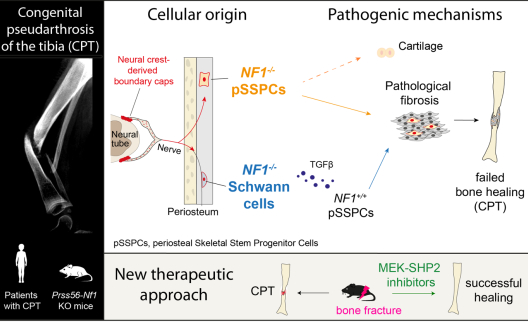Publication in the journal Science Translational Medicine of a study by Céline Colnot’s group in the Relaix team on the pathogenic mechanisms and pharmacological treatment of congenital pseudarthrosis of the tibia in Neurofibromatosis type 1.
 Congenital pseudarthrosis of the tibia (CPT) is a severe pathology affecting children and characterized by spontaneous fractures that fail to heal. Half of patients with CPT are also diagnosed with the genetic disorder neurofibromatosis type 1 (NF1), caused by mutations in the NF1 gene.
Congenital pseudarthrosis of the tibia (CPT) is a severe pathology affecting children and characterized by spontaneous fractures that fail to heal. Half of patients with CPT are also diagnosed with the genetic disorder neurofibromatosis type 1 (NF1), caused by mutations in the NF1 gene.
Perrin et al. uncovered that Schwann cells and skeletal stem/progenitor cells in periosteum both carry NF1 biallelic inactivation in patients with CPT. The study reports that both cell types are responsible for the fibrotic failure to heal in a relevant NF1 KO mouse model, revealing the common cellular origin of CPT and other NF1 symptoms such as neurofibromas. The authors successfully tested a combination of MEK and SHP2 inhibitors to prevent fibrous nonunion in NF1 KO mice, opening new therapeutic perspectives.
This study was carried out in collaboration with Piotr Topilko’s group at the IMRB, Béatrice Parfait at the Institut Cochin and the orthopaedic surgery department at the Hopital
Necker-Enfants Malades, with the support of the ANR, Association Neurofibromatoses et Recklinghausen, United States Department of Defense, National Institute of Arthritis and Musculoskeletal and Skin Diseases, Osteosynthesis and Trauma Care Foundation.
Access to article (full-text via Insermbiblio)

